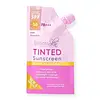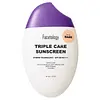Brilliant Skin Essentials, Inc. Tinted Sunscreen Sunprofessional SPF50 PA+++ Versus Facetology Triple Care Tinted Sunscreen SPF 50
What's inside
What's inside
 Key Ingredients
Key Ingredients

 Benefits
Benefits

 Concerns
Concerns

 Ingredients Side-by-side
Ingredients Side-by-side

Water
Skin ConditioningEthylhexyl Methoxycinnamate
UV AbsorberCaprylyl Methicone
Skin ConditioningPEG-12 Dimethicone
Skin ConditioningSodium Acrylates Copolymer
Lecithin
EmollientTitanium Dioxide
Cosmetic ColorantNiacinamide
SmoothingDimethicone
EmollientCucumis Sativus Fruit Extract
EmollientGlycerin
HumectantCodonopsis Lanceolata Extract
AntioxidantEthylhexylglycerin
Skin ConditioningPhenoxyethanol
PreservativeChamomilla Recutita Extract
Skin ConditioningAloe Barbadensis Leaf Juice
Skin ConditioningAloe Ferox Leaf Juice Extract
Skin ConditioningCI 77891
Cosmetic ColorantCI 77492
Cosmetic ColorantCI 77491
Cosmetic ColorantCI 77499
Cosmetic ColorantParfum
MaskingXanthan Gum
EmulsifyingDisodium EDTA
Water, Ethylhexyl Methoxycinnamate, Caprylyl Methicone, PEG-12 Dimethicone, Sodium Acrylates Copolymer, Lecithin, Titanium Dioxide, Niacinamide, Dimethicone, Cucumis Sativus Fruit Extract, Glycerin, Codonopsis Lanceolata Extract, Ethylhexylglycerin, Phenoxyethanol, Chamomilla Recutita Extract, Aloe Barbadensis Leaf Juice, Aloe Ferox Leaf Juice Extract, CI 77891, CI 77492, CI 77491, CI 77499, Parfum, Xanthan Gum, Disodium EDTA
Water
Skin ConditioningCyclopentasiloxane
EmollientEthylhexyl Methoxycinnamate
UV AbsorberCetyl Alcohol
EmollientTitanium Dioxide
Cosmetic ColorantGlycerin
HumectantNiacinamide
SmoothingTalc
AbrasiveCentella Asiatica Extract
CleansingNylon 6/12
AbsorbentCetearyl Alcohol
EmollientZinc Oxide
Cosmetic ColorantButyl Methoxydibenzoylmethane
UV AbsorberButylene Glycol
HumectantGlyceryl Stearate
EmollientOctocrylene
UV AbsorberPropylene Glycol
HumectantCeteareth-20
CleansingPEG-40 Stearate
EmulsifyingPolyacrylamide
Triethoxycaprylylsilane
Aluminum Hydroxide
EmollientEthylhexyl Salicylate
UV AbsorberArtemisia Vulgaris Extract
Skin ConditioningIsopropyl Titanium Triisostearate
EmollientMethylene Bis-Benzotriazolyl Tetramethylbutylphenol
UV FilterLecithin
EmollientMica
Cosmetic ColorantLaureth-7
EmulsifyingOryza Sativa Extract
AbsorbentOryza Sativa Germ Extract
EmollientDecyl Glucoside
CleansingAcetyl Glucosamine
Skin ConditioningCaprylhydroxamic Acid
Ethylhexylglycerin
Skin ConditioningBroussonetia Papyrifera Bark Extract
Skin ConditioningMorus Alba Bark Extract
Skin ConditioningRhus Semialata Extract
Skin ConditioningCamellia Japonica Flower Extract
EmollientCamellia Sinensis Leaf Extract
AntimicrobialMadecassoside
AntioxidantPyrus Malus Fruit Extract
Skin ConditioningCitric Acid
BufferingXanthan Gum
EmulsifyingTricholoma Matsutake Extract
Skin ConditioningTranexamic Acid
AstringentPhragmites Communis Extract
Skin ConditioningPoria Cocos Extract
Skin ConditioningPhenoxyethanol
PreservativePotassium Sorbate
PreservativeSodium Benzoate
MaskingCI 77491
Cosmetic ColorantCI 77492
Cosmetic ColorantCI 77499
Cosmetic ColorantWater, Cyclopentasiloxane, Ethylhexyl Methoxycinnamate, Cetyl Alcohol, Titanium Dioxide, Glycerin, Niacinamide, Talc, Centella Asiatica Extract, Nylon 6/12, Cetearyl Alcohol, Zinc Oxide, Butyl Methoxydibenzoylmethane, Butylene Glycol, Glyceryl Stearate, Octocrylene, Propylene Glycol, Ceteareth-20, PEG-40 Stearate, Polyacrylamide, Triethoxycaprylylsilane, Aluminum Hydroxide, Ethylhexyl Salicylate, Artemisia Vulgaris Extract, Isopropyl Titanium Triisostearate, Methylene Bis-Benzotriazolyl Tetramethylbutylphenol, Lecithin, Mica, Laureth-7, Oryza Sativa Extract, Oryza Sativa Germ Extract, Decyl Glucoside, Acetyl Glucosamine, Caprylhydroxamic Acid, Ethylhexylglycerin, Broussonetia Papyrifera Bark Extract, Morus Alba Bark Extract, Rhus Semialata Extract, Camellia Japonica Flower Extract, Camellia Sinensis Leaf Extract, Madecassoside, Pyrus Malus Fruit Extract, Citric Acid, Xanthan Gum, Tricholoma Matsutake Extract, Tranexamic Acid, Phragmites Communis Extract, Poria Cocos Extract, Phenoxyethanol, Potassium Sorbate, Sodium Benzoate, CI 77491, CI 77492, CI 77499
Ingredients Explained
These ingredients are found in both products.
Ingredients higher up in an ingredient list are typically present in a larger amount.
Ci 77491 is also hydrated iron III oxide. It's sole purpose is to give a red/pink hue to products.
Iron III oxides are classified as inorganic chemicals for coloring.
Synthetically created Ci 77491 is considered safer than those naturally found. This is because the synthetically created version may contain less impurities. Iron oxides are generally non-toxic and non-allergenic.
Learn more about CI 77491Ci 77492 is also hydrated iron III oxide. It's sole purpose is to give a yellow hue to products.
Iron III oxides are classified as inorganic chemicals for coloring.
Synthetically created Ci 77492 is considered safer than those naturally found. This is because the synthetically created version may contain less impurities. Iron oxides are generally non-toxic and non-allergenic.
Learn more about CI 77492Ci 77499 is also hydrated iron III oxide. It is created from mixing red and black iron oxides. This helps give shades of darkness to a product.
Iron III oxides are classified as inorganic chemicals for coloring.
Ethylhexyl Methoxycinnamate is an organic compound that provides UVB protection. It often goes by the more common name of octinoxate. It is created from methoxycinnamic acid and 2-ethylhexanol.
Ethylhexyl Methoxycinnamate absorbs UVB rays with wavelengths between 280-320 nm. UV absorbers protect your skin by using chemical reactions to convert UV rays into heat and energy.
UVB (290-320 nm) rays emit more energy than UVA rays. They are capable of damaging DNA, causing sunburns and are thought to be linked to skin cancer.
The state of Hawaii has banned sunscreens containing octinoxate due to its potential impact on coral reefs. More research is needed to bridge gaps in this research. The European Union allows higher levels of octinoxate in sunscreens than the US and Australia.
Ethylhexyl Methoxycinnamate is oil soluble. It is not stable and may lose efficacy when exposed to sunlight.
Learn more about Ethylhexyl MethoxycinnamateEthylhexylglycerin (we can't pronounce this either) is commonly used as a preservative and skin softener. It is derived from glyceryl.
You might see Ethylhexylglycerin often paired with other preservatives such as phenoxyethanol. Ethylhexylglycerin has been found to increase the effectiveness of these other preservatives.
Glycerin is already naturally found in your skin. It helps moisturize and protect your skin.
A study from 2016 found glycerin to be more effective as a humectant than AHAs and hyaluronic acid.
As a humectant, it helps the skin stay hydrated by pulling moisture to your skin. The low molecular weight of glycerin allows it to pull moisture into the deeper layers of your skin.
Hydrated skin improves your skin barrier; Your skin barrier helps protect against irritants and bacteria.
Glycerin has also been found to have antimicrobial and antiviral properties. Due to these properties, glycerin is often used in wound and burn treatments.
In cosmetics, glycerin is usually derived from plants such as soybean or palm. However, it can also be sourced from animals, such as tallow or animal fat.
This ingredient is organic, colorless, odorless, and non-toxic.
Glycerin is the name for this ingredient in American English. British English uses Glycerol/Glycerine.
Learn more about GlycerinLecithin is a term for a group of substances found in the cell membranes of plants, animals, and humans. They are made up of mixture of phospholipids.
This ingredient has emollient and emulsifying properties.
As an emollient, lecithen helps soften the skin and creates a barrier to keep moisture in.
As an emulsifier, it also helps prevent water and oil ingredients from separating. Lecithin can also help ingredients be better absorbed by the skin.
This is because the phospholipids in lecithin produce liposomes. Liposomes help other ingredients get through the skin barrier.
Depending on the source of this ingredient, lecithin may not be fungal acne safe. This is because some sources of lecithin come from soybean oil, which may feed the malassezia yeast that feeds fungal acne.
We recommend reaching out to the brand you are purchasing from to inquire about the source of their lecithin.
Some other names for this ingredient include soy lecithin and deoiled soy lecithin.
Learn more about LecithinNiacinamide is a multitasking form of vitamin B3 that strengthens the skin barrier, reduces pores and dark spots, regulates oil, and improves signs of aging.
And the best part? It's gentle and well-tolerated by most skin types, including sensitive and reactive skin.
You might have heard of "niacin flush", or the reddening of skin that causes itchiness. Niacinamide has not been found to cause this.
In very rare cases, some individuals may not be able to tolerate niacinamide at all or experience an allergic reaction to it.
If you are experiencing flaking, irritation, and dryness with this ingredient, be sure to double check all your products as this ingredient can be found in all categories of skincare.
When incorporating niacinamide into your routine, look out for concentration amounts. Typically, 5% niacinamide provides benefits such as fading dark spots. However, if you have sensitive skin, it is better to begin with a smaller concentration.
When you apply niacinamide to your skin, your body converts it into nicotinamide adenine dinucleotide (NAD). NAD is an essential coenzyme that is already found in your cells as "fuel" and powers countless biological processes.
In your skin, NAD helps repair cell damage, produce new healthy cells, support collagen production, strengthen the skin barrier, and fight environmental stressors (like UV and pollution).
Our natural NAD levels start to decline with age, leading to slower skin repair, visible aging, and a weaker skin barrier. By providing your skin niacinamide, you're recharging your skin's NAD levels. This leads to stronger, healthier, and younger looking skin.
Another name for vitamin B3 is nicotinamide. This vitamin is water-soluble and our bodies don't store it. We obtain Vitamin B3 from either food or skincare. Meat, fish, wheat, yeast, and leafy greens contain vitamin B3.
The type of niacinamide used in skincare is synthetically created.
Learn more about NiacinamidePhenoxyethanol is a preservative that has germicide, antimicrobial, and aromatic properties. Studies show that phenoxyethanol can prevent microbial growth. By itself, it has a scent that is similar to that of a rose.
It's often used in formulations along with Caprylyl Glycol to preserve the shelf life of products.
Titanium dioxide is a mineral UV filter widely used in sunscreens and cosmetics.
It is one of only two UV filters officially classified as “mineral” by regulatory agencies, the other being zinc oxide.
Titanium dioxide provides broad-spectrum protection mostly in the UVB and UVAII range, with some protection in the UVAI range.
While its UVA protection isn’t as strong as zinc oxide’s, the difference is minor.
A common myth is that mineral UV filters reflect UV light. However, modern research shows titanium dioxide absorbs UV radiation like chemical filters (~95% absorption & 5% reflection).
Thanks to its non-irritating nature, titanium dioxide is suitable for sensitive, acne-prone, or redness-prone skin. It is unlikely to cause "eye sting" like other sunscreen ingredients.
A major drawback of this ingredient is its white cast and thick texture. This is why mineral sunscreens often leave a white cast and are less cosmetically elegant than chemical/hybrid sunscreens.
To improve white cast and spreadability, micronized or nano-sized titanium dioxide is often used.
There are ongoing concerns surrounding nano-titanium oxide's impact on marine ecosystems.
There is no conclusive evidence that any form of titanium oxide (or any other sunscreen ingredients) will cause harm to marine ecosystems or coral reefs. The science is still developing but many consumers are keeping a close eye on this issue.
Please note, many destinations have reef-safety sunscreen rules. For instance, the U.S. Virgin Islands advises all visitors to use non-nano mineral sunscreens.
Nano mineral sunscreens once raised safety concerns about absorption into skin.
Extensive research has shown that they do not penetrate healthy or damaged skin; they remain safely on the surface and the top layer of dead skin (stratum corneum).
You'll likely find titanium dioxide bundled with alumina, silica, or dimethicone. These ingredients help make titanium dioxide highly photostable; this prevents it from interacting with other formula components under UV light.
Learn more about Titanium DioxideWater. It's the most common cosmetic ingredient of all. You'll usually see it at the top of ingredient lists, meaning that it makes up the largest part of the product.
So why is it so popular? Water most often acts as a solvent - this means that it helps dissolve other ingredients into the formulation.
You'll also recognize water as that liquid we all need to stay alive. If you see this, drink a glass of water. Stay hydrated!
Learn more about WaterXanthan gum is used as a stabilizer and thickener within cosmetic products. It helps give products a sticky, thick feeling - preventing them from being too runny.
On the technical side of things, xanthan gum is a polysaccharide - a combination consisting of multiple sugar molecules bonded together.
Xanthan gum is a pretty common and great ingredient. It is a natural, non-toxic, non-irritating ingredient that is also commonly used in food products.
Learn more about Xanthan Gum